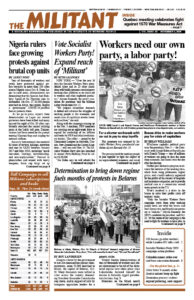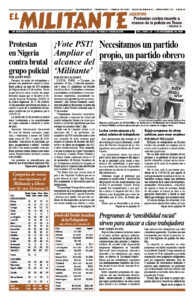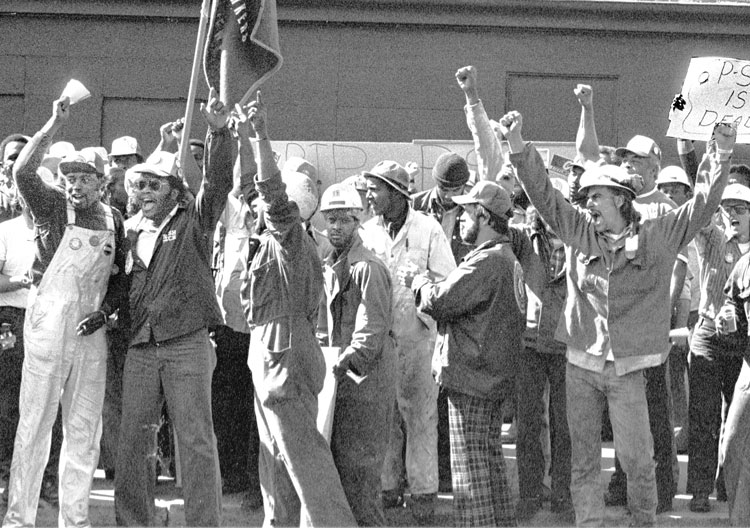One of Pathfinder’s Books of the Month for October is Labor’s Giant Step — The First Twenty Years of the CIO: 1936-55 by Art Preis. Preis, a participant in labor battles in the 1930s, became a staff writer for the Militant. His book deals with the great upheavals of the class struggle that built stronger industrial unions in the U.S. This excerpt describes how the CIO officialdom failed to seize the openings to build unions in the South by organizing all workers, Black and Caucasian alike. Despite the social revolution of the civil rights movement of the 1960s and ’70s overturning Jim Crow segregation, this failure has left a lasting legacy of a weaker labor movement in the country. Copyright © 1972 by Pathfinder Press. Reprinted by permission.
BY ART PREIS
Even more appalling has been the record of the official labor bureaucracy on the organization of the South, the most formidable citadel of both the anti-Negro and anti-union elements in the country. The open-shop South, with its low living standards and cheap labor supply, has been for decades the chief haven for runaway plants from the North, particularly in the textile industry. During the late 1920’s the old AFL had launched a special campaign to organize the South. Twenty years later [George] Baldanzi [executive vice president of the Textile Workers Union] blamed the failure of the CIO in this area on the Communist Party which, during its early period, had made the greatest sacrifices and most heroic efforts to help organize the Southern textile and agricultural workers.
The question of the organization of the South, which looms with especial magnitude because of the great Negro upsurge of the past decade, touches on some of the gravest weaknesses in the policies and methods of the American labor bureaucracy.
The CIO in its rise represented a great step forward in many spheres, including that of racial integration. It was founded on the principle of no discrimination. All forms of the color line were constitutionally banned from all CIO affiliates and from the national CIO. This was a far cry from the traditional situation in the AFL and railroad brotherhoods. As late as the AFL-CIO merger in 1955, there were still some thirty AFL international unions with constitutional color bars and restrictions.
At its peak membership of six million, the CIO included a half million Negro workers. They were a significant force in such major unions as steel, automobile and packinghouse. At the 1947 convention of the CIO packinghouse workers, one-third of all the delegates were Negroes. This does not mean that Negro workers achieved equality with all other workers in the CIO-organized industries or even were accorded their proper representation in the unions. The CIO did a little to change the discriminating corporation pattern in the hiring and upgrading of the Negro, but he remained the last hired and the first fired, and was restricted to the hardest, dirtiest and lowest-paid work. The CIO did give him, where he was able to enter basic industries, union status and a measure of union protection. In return, the Negro worker gave the CIO unbounded loyalty and fighting support.
Just before Pearl Harbor, at the 1941 CIO convention, a campaign was initiated to organize the South. This campaign was to be, in [President] Philip Murray’s words, the CIO’s “Task Number One.” The CIO leadership, which included the Stalinists, abandoned this number one task during the whole of World War II, just as they sacrificed the general interests of labor to the demands of the capitalist war machine.
During the war, the insistent demand of the Negro workers for jobs in the better-paying war industries and for an end to segregation in housing and education led to the establishment in 1944 of the CIO Committee to Abolish Racial Discrimination. Between March 15 and August 15, state and local committees had increased from 50 to 85, with organizations even in Georgia, North Carolina, West Virginia, Kentucky, Texas, Kansas and Alabama. They succeeded in winning a number of cases involving such issues as job upgrading and integrated government housing. But this CIO activity did not touch at the core of the problem. The vast Southland remained generally unorganized and constantly fed the springs of anti-Negro and anti-labor poison throughout the country. In the South, the issues of civil rights and labor rights fused.
In May 1946, the CIO opened what was announced as its greatest organizing campaign since the 1936-37 founding drive — a campaign called “Operation Dixie.” This phrase indicated a grand offensive to be run with the power, precision and organization of a military drive. Murray called it a “crusade” to mobilize not less than one million Southern workers into the CIO within a year. To this end the national CIO sent 400 organizers to key selected points in the South and placed a million-dollar fund at their disposal.
On the occasion of the opening of “Operation Dixie,” I wrote in the May 4, 1946 Militant an estimation of the scope of the task and what was required to carry it out successfully: “United organization of the cruelly exploited Southern Negro and white workers would constitute the first great advance in what inevitably must develop into a social, economic and political struggle aimed at a profound transformation of the entire South. … Anyone acquainted with the Southern scene recognizes that a real drive to bring the white and Negro workers together will be resisted with all the ferocity and violence that the Southern ruling class can muster. … Any policy that … seeks to confine itself to the most narrow trade-union aims or tries to adapt itself … to the prejudices of the Southern system can only hamper and weaken ‘Operation Dixie.’” …
The reason for the failure of “Operation Dixie” was not the Stalinists. Their contribution to its failure had been the same as that of the official CIO bureaucracy. It was impossible to support the Democratic Party and not reinforce its Southern wing, the chief political prop of the Jim Crow system and one-party dictatorship in the South. The CIO leaders refused to wage political war against the Southern ruling class because that would undermine the whole Democratic Party and put an end to the Democratic Party-labor coalition. The Stalinists had supported that policy and had reinforced the leadership in its bankrupt political course.


